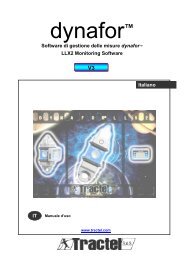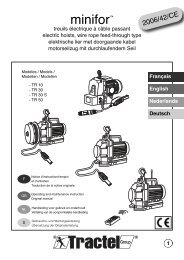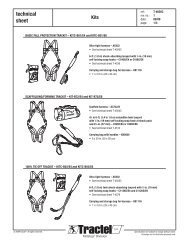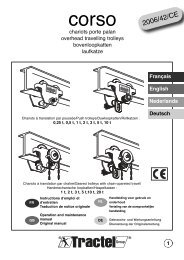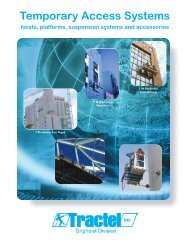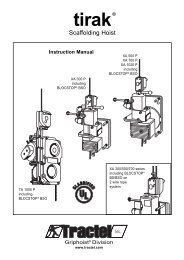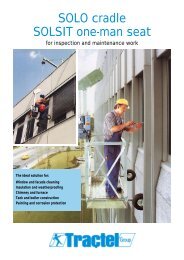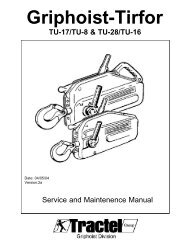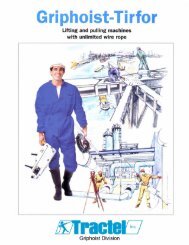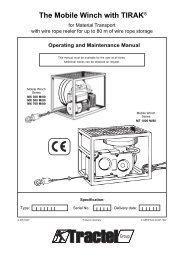rollbeam- EN 795 -B - Tractel
rollbeam- EN 795 -B - Tractel
rollbeam- EN 795 -B - Tractel
You also want an ePaper? Increase the reach of your titles
YUMPU automatically turns print PDFs into web optimized ePapers that Google loves.
3. Place the assembled device under the beam, maintaining asufficient distance between the clamp plates to be able toposition the trolley on the beam.4. Place the two rollers on one of the clamp plates on the flangeof the beam.5. Line up the other two rollers with the flange on the bar andturn the handle clockwise to tighten the clamp plates.6. Adjust the distance between the clamp plates so thatthe 4 rollers are in contact with the flange and that thedistance between the flange and the cheek of the roller is5 mm.7. Tighten the locknuts against the clamp plates. At least onethread on the threader bar must protrude beyond the locknuts.8. Tighten the Allen screws on the threader bar.9. Remove the adjustment handle.NB: The threader bar has a left-handed thread on one end and aright-handed thread on the other.Preparation for operation• Check that all the parts of the trolley have been correctlyassembled and tightened.• Check that the trolley moves easily and freely along the wholelength of the beam.• Check that the profile of the beam used is adequate to take aforce of 10 kN per <strong>rollbeam</strong> in complete safety.• Check that the end stops on the beam work properly.RemovalThe <strong>rollbeam</strong> may be removed after use.1. Loosen the locking screws.2. Loosen the locknuts.3. Fit the handle on the crossbeam.4. Move the clamp plates apart by turning the handle (caution:remember the weight of the trolley during removal).5. Remove the handle.OperationThe high quality operation of the <strong>rollbeam</strong> ensures optimummovement along a beam. While moving or working, the operatormust remain in the working area. Angle α should not exceed20° ie. d < 0.4xH.For any application other than those explicitly describedabove, please contact your TRACTEL installer (figure 4and 5).Before each use of the <strong>rollbeam</strong>:• Visual inspection of the device.• Check the compatibility of the <strong>rollbeam</strong> with the equipmentused.• The <strong>rollbeam</strong> must be checked in the event of a fall, if there isany obvious deformation or any other change in appearance(contact your TRACTEL installer).• The standard recommends that the <strong>rollbeam</strong> is inspectedregularly, at least once a year.CAUTIONThe following precautions must be taken when moving thetrolley:• Avoid the <strong>rollbeam</strong> regularly running into the end stopsfitted on the beam.• Avoid moving at high speed.• Avoid impact between trolleys on the same beam.• Check that the bend radius of the beam is at least 1m.• If the <strong>rollbeam</strong> is used periodically on the same beam,inspect that beam regularly.• Check that the mounting clearance is observed.• During use, protect your PPE against any risks connectedwith the working environment eg. thermal, electricalor mechanical shocks, splashes of acid, etc.Warnings against hazardous operationssThe following is prohibited: s• Use of a device which has stopped a fall and which has notbeen overhauled.• Using one <strong>rollbeam</strong> for the protection of a number of people.• Use of the <strong>rollbeam</strong> for purposes other than the fall protectionof one person.• Moving outside the safety area of 20° around the <strong>rollbeam</strong>.• Attaching oneself to the device by any means other thanthe PPE attachment point.• Fitting the <strong>rollbeam</strong> on a sloping beam.• Placing the device on an unsuitable support, leading to the riskof damage to the components of the trolley.• Repairing the device with spare parts not referenced andvalidated by TRACTEL.• Allowing the trolley to be used by a person who is unqualifiedor who has not read this manual.• Using the device in operating conditions or an environment notsuitable for its characteristics.• Moving or removing the end stops fitted at the ends of thebeam.• Using a trolley which is not in perfect condition (wear ordeformation).• Removing the safety devices from the trolley and usingthe <strong>rollbeam</strong> without these devices.• Fitting the trolley on the beam by any means other than thosedescribed in this manual.• Placing the trolley on a beam whose resistance and conditionhave not been checked beforehand.Permissible attachments+ A connector (<strong>EN</strong> 362).+ A fall arrest ( <strong>EN</strong> 3XX).+ A connector (<strong>EN</strong>362).+ A harnes (NF <strong>EN</strong> 361)(chest or back anchorage point).Operating problemsIf there are any friction points or localised binding on the beam:• Check that there are no obstacles on the beam.• Check that the axles of the rollers are not damaged and thatthey turn correctly.• Check that the distance adjustment of the trolley is correct inrelation to the width of the beam.• Check that the beam does not have a bend radius smaller thanthe technical capabilities of the trolley used.• Check that the beam has no localised deformations and that itis not twisted.• Check the surface condition ofGroup7GB



